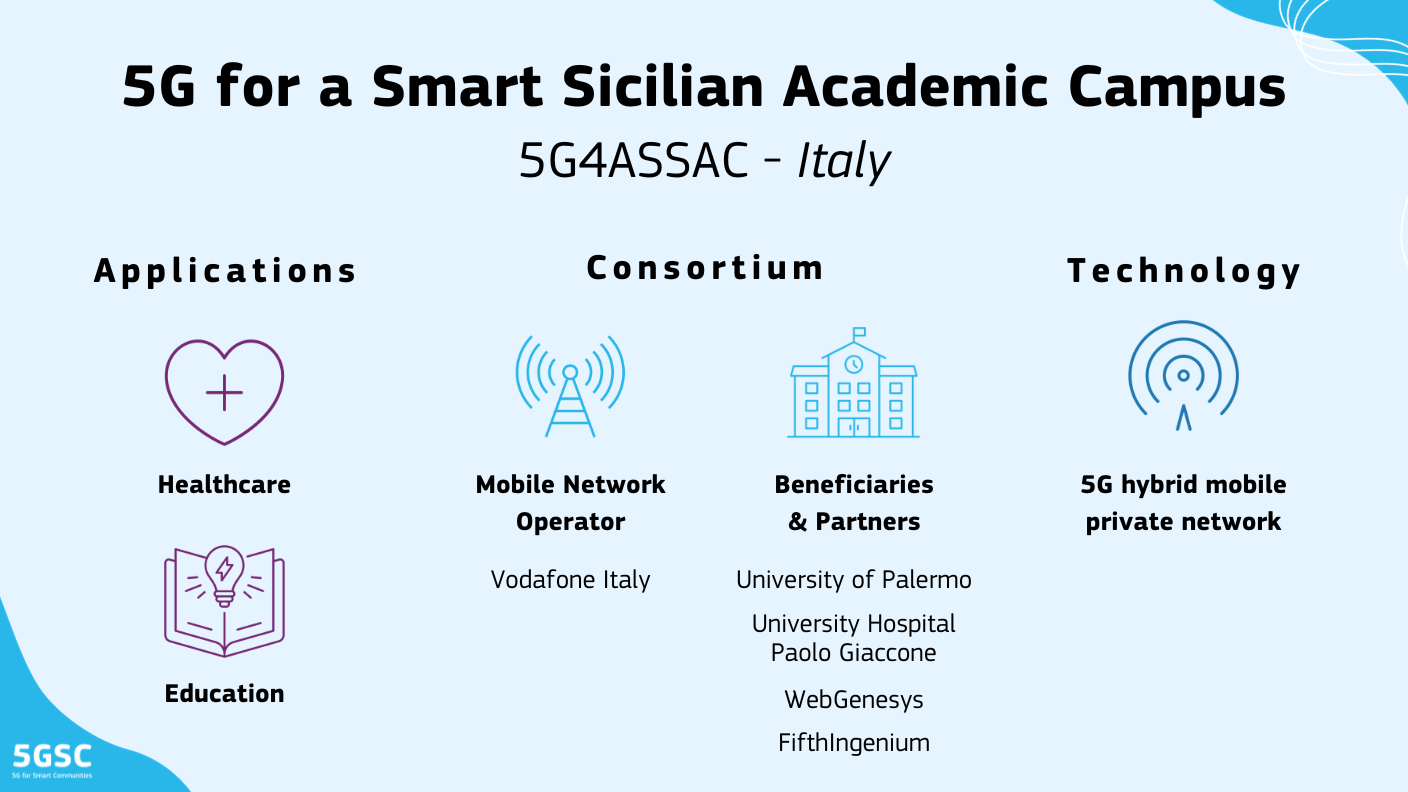

| Location | Italy – Sicily: cities of Palermo and Trapani |
| Sectors | Education (in particular, medical students and researchers) Health |
| Network type | Hybrid 5G mobile private network architecture |
| Project start - end date (duration) | 1 January 2023 ‑ 31 December 2025 (36 months) |
| Total budget | €5.3 million |
| EU contribution | €4 million |
| Lead entity / organisations | Vodafone Italy - Mobile Network Operator (MNO) |
| Beneficiaries and partners | University of Palermo University Hospital Paolo Giaccone Sub‑contractors: Webgenesys and FifthIngenium |
The University of Palermo and the University Hospital Paolo Giaccone will offer new approaches to medical learning, research and information sharing, as well as the remote management of patients.
To achieve this, the project will deploy a 5G Mobile Private Network (MPN) in the university campuses of Palermo and Trapani, in Sicily, Italy
What will it provide?
The smart campus’ Mixed Reality Learning Platform will allow the medical students and researchers to use new immersive learning and training techniques, such as through Augmented Reality (AR) or Virtual Reality (VR), combined with Machine Learning‑enabled adaptive learning and training programmes. The Platform will allow the use of multiple devices, from PCs and smartphones to a new generation of eXtended Reality (XR) devices. Thanks to this, students and researchers will have access to the simulation‑based e‑health Learning Management System (LMS), which creates interactive clinical scenarios.
Use of the Platform will also help generate and collect large amounts of data and insights to optimise both learning and training processes, as well as providing a solid basis for improving care methods.
In addition to the use of the Platform by the students and researchers, the smart campus will provide 5G coverage to 500-1000 users at both locations.
How will it work?
The project will provide a hybrid 5G MPN architecture to allow users the flexibility to:
- access traditional public services through public cloud applications as well as through on‑premise application platforms directly connected to the network platform (local core edge);
- remotely access on‑premise applications from the Trapani remote site, outside the University of Palermo MPN area;
- user devices equipped with a standard 5G Vodafone SIM or with dedicated SIM (a hybrid network can behave as both a traditional 5G Public Network and a Mobile Private Network (MPN);
- employ a range of devices, from traditional PCs and smartphones to a new generation of XR devices based on the OpenXR standard.
The network will support up to 100 times higher user and device density than currently possible, with data transmission speeds up to 10 times faster than 4G, and 15-20ms latency end-to-end thanks to the direct connection between the network platform (local core edge) and the application platform (Multi‑Access Edge Computing (MEC) infrastructure). This will be 30‑50 times lower latency than at present.
How will it be built?
The project will implement a new 5G infrastructure, including 5 base stations and 18 Distributed Antenna Systems (DAS), to provide capillary indoor coverage as well as outdoor coverage.
Vodafone will then integrate its software technologies and infrastructures with the Multi‑Access Edge Computing (MEC) infrastructure of the University of Palermo.
How is it financed?
The 5G4ASSAC project has a total budget of €5.3 million, of which €4 million under the Connecting Europe Facility (CEF) Digital programme. With regard to long-term financing, the smart campus planned revenue streams comprise:
- Subscription fees for network users, including the general public, students from UNIPA studying in different departments, hospital staff and researchers of the University Hospital Paolo Giaccone.
- Licenses for the use of infrastructures by third party operators, such as tech companies implementing use cases that involve 5G4ASSAC‑developed infrastructures.
- New courses enabled by the 5G infrastructure that can be offered to students and professors, including from other university departments.
Who is involved?
The 5G4ASSAC project is run by a multidisciplinary consortium, including:
- Vodafone: Mobile Network Operator
- The University of Palermo: managing the Services of General Interest (SGI)
- The Paolo Giaccone University Hospital
- Webgenesys and FifthIngenium: private entities with expertise in Immersive Learning and e‑health solutions, as well as 5G Research and Development.
How can I find out more about the project?
The European Health and Digital Executive Agency (HaDEA)
Contact HaDEA
Read more:
- Presentation
- Vodafone press release
- Vodafone Italia press release
- University of Palermo press release
Related websites and social media:
